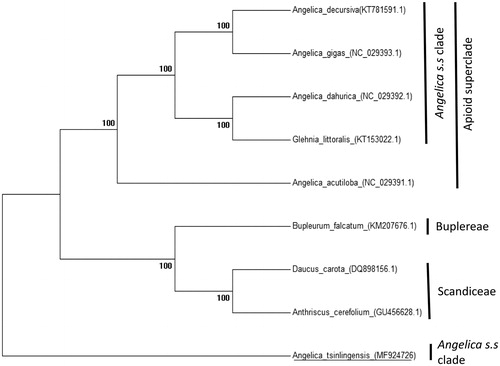Abstract
Angelica tsinlingensis is endemic in Shaanxi province (China), and is used as Angelica sinensis in folk. Owing to important medicinal value, wild A. sinensis has been over-exploited and become quite rare in China during over 2000 years. Angelica sensu lato (s.l.; Apiaceae subfamily Apioideae) is a taxonomically complex and controversial group, and A. tsinlingensis is clearly different from members of the Angelica s.s. clade with the morphological and molecular results. The complete chloroplast DNA sequence of A. tsinlingensis (GenBank accession number: MF924726) was determined in our study. The size of chloroplast genome of A. tsinlingensis is 147,104 bp, including a large single-copy (LSC) region of 93376 bp and a small single-copy (SSC) region of 17,574 bp separated by a pair of identical inverted repeat regions (IRs) of 18,077 bp each. A total of 125 genes were successfully annotated containing 83 protein-coding genes, 34 tRNA genes and 8 rRNA genes. GC content of IRs region is the highest (44.5%). The result of Phylogenomic analysis supports the difference of A. tsinlingensis from Angelica s.s. clade.
Angelica tsinlingensis is endemic in Shaanxi province (China), and is used as Angelica sinensis, a traditional Chinese herb used in female health related diseases, in folk (Li et al. Citation1993; Mazaro-Costa et al. Citation2010). In addition to its medicinal uses, A. sinensis is also used as a health food, a cosmetic and a dietary supplement in Asia, Europe and America (Filipiak-Szok et al. Citation2014). Owing to important medicinal value, wild A. sinensis has been over-exploited and become quite rare in China during over 2000 years (Zhang et al. Citation2012). Angelica sensu lato (s.l.; Apiaceae subfamily Apioideae) is a taxonomically complex and controversial group, exhibiting much morphological diversity and problematic generic limits. A. tsinlingensis is clearly different from members of the Angelica s.s. clade with its thin-winged dorsal ribs and triple vittae in each furrow and this discordance corresponds with the molecular results in placing A. tsinlingensis outside of the Angelica s.s. clade (Liao et al. Citation2013). In present study, the completed chloroplast genome sequence of A. tsinlingensis is reported contributing to conservation of this species and providing significant information for the complex taxon of Apioideae.
Fresh leaves of A. tsinlingensis were collected from greenhouse of National Engineering laboratory for Resource Developing of Endangered Chinese Crude Drugs in Northwest of China (108°53′30″E, 34°9′14″N; NSII accession number C072801, http://www.nsii.org.cn/2017/specimen.php?id =17426473) in Xi’an city. Those leaves were stored in the refrigerator at −80 °C. Total genome DNA of A. tsinlingensis was sequenced by Illumina Hiseq 2500 Sequencing System (Illumina, Hayward, CA) to construct the shotgun library. The low quality sequences were filtered out Using CLC Genomics Workbench v8.0 (CLC Bio, Aarhus, Denmark) and then reconstructed the chloroplast genome by using MITObim v1.8 (University of Oslo, Oslo, Norway; Kaiseraugst, Switzerland) (Hahn et al. Citation2013), with Angelica acutiloba (GenBank: NC_029391.1) as the reference. The complete chloroplast genome of A. tsinlingensis was annotated in Geneious R9 (v9.0.2) (Wang et al. Citation2017) and then submitted to GenBank (accession no. MF924726).
The size of chloroplast genome of A. tsinlingensis is 147,104 bp, including a large single-copy (LSC) region of 93376 bp and a small single-copy (SSC) region of 17,574 bp separated by a pair identical inverted repeat regions (IRs) of 18,077 bp each. A total of 125 genes were successfully annotated containing 83 protein-coding genes, 34 tRNA genes and 8 rRNA genes. GC content of the whole genome, IRs, LSC and SSC regions are 37%, 44.5%, 35.4% and 30.3%, respectively. GC content of IRs region is the highest. 18 genes contain one intron, while 2 genes have two introns.
The complete chloroplast genome sequence of A. tsinlingensis and other species from Apioideae were used to construct phylogenetic tree (). A neighbour-joining (NJ) tree was performed with Mega 6.0 using 1000 bootstrap replicates (Tamura et al. Citation2013). The result shows the difference of A. tsinlingensis from Angelica s.s. clade, which is consistent with morphological and molecular results (Liao et al. Citation2013).
Disclosure statement
The authors report no conflicts of interest.
Additional information
Funding
References
- Filipiak-Szok A, Kurzawa M, Szłyk E. 2014. Evaluation of antioxidants in Dong quai (Angelica sinensis) and its dietary supplements. Chem Pap. 68:493–503.
- Hahn C, Bachmann L, Chevreux B. 2013. Reconstructing mitochondrial genomes directly from genomic next-generation sequencing reads – a baiting and iterative mapping approach. Nucleic Acids Res. 41:e129.
- Liao CY, Downie SR, Li QQ, Yu Y, He XJ, Zhou B. 2013. New insights into the phylogeny of Angelica and its Allies (Apiaceae) with emphasis on east Asian species, inferred from nrDNA, cpDNA, and morphological evidence. System Bot. 38:266–281.
- Li YL, Lu JX, Wang XW. 1993. Pharmacognostical study on the root of Angelica Tsinlingensis K. T. Fu. J Xi’an Jiaotong Univ. 14:230–233.
- Mazaro-Costa R, Andersen ML, Hachul H, Tufik S. 2010. Medicinal plants as alternative treatments for female sexual dysfunction: Utopian vision or possible treatment in climacteric women. J Sex Med. 7:3695–3714.
- Tamura K, Stecher G, Peterson D, Filipski A, Kumar S. 2013. MEGA6: molecular evolutionary genetics analysis version 6.0. Mol Biol Evol. 30:2725–2729.
- Wang XF, Yang N, Su J, Zhang H, Cao XY. 2017. The complete chloroplast genome of Gentiana macrophylla. Mitochondrial DNA Part B. 2:2:395–396.
- Zhang HY, Bi WG, Yu Y, Liao WB. 2012. Angelica sinensis (Oliv.) Diels in China: distribution, cultivation, utilization and variation. Genet Resour Crop Evol. 59:607–613.

